If you are looking for a Japanese cast iron teapot or kettle, you’ll come across a company called Iwachu. Whether you want a bright and cheerful teapot or a traditional kettle, Iwachu has you covered with its wide range of cast iron hollowware. With over 100 years of expertise, Iwachu makes some of the best cast-iron teapots, kettles, and cookware.
Table Of Contents
- Company information
- History of Iwachu
- How Iwachu make teapots and kettles
- Learn about popular products
- Helpful tips to use and maintain your Iwachu ironware
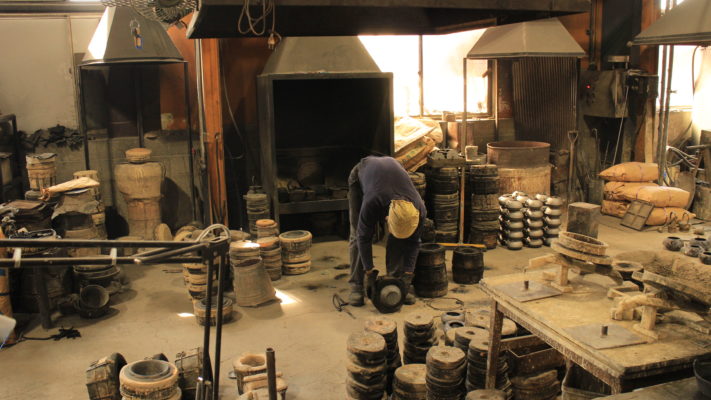
Table: Company Information
Iwachu origins | The company has its origins in Morioka. It is the location of one of the two most prominent cast-iron regions in Japan. |
Located | Address 2 Chome-23-9 Minamisenboku, Morioka, Iwate Japan 020-0863 Google Maps |
Founder | Iwachu was founded in 1902 by Sueyoshi Iwashimizu |
Ownership | Iwachu is owned by N & I Asia Pte Ltd. A Japanese company headquartered in Singapore. (N & I Asia Pte Ltd website) Address 40 Jln Pemimpin, #04-11 Tat Ann Building, Singapore 577185 Google Maps |
Type of casting | The foundry is a big operation; the company makes most products using green sand-casting. |
Signature product | Iwachu is best known for its range of teapots. But they also have a beautiful selection of brightly colored teapots and a line of cast-iron cookware. |
History of Iwachu Castings
The Iwachu brand was founded in 1902 by Sueyoshi Iwashimizu in Iwate, Japan. Iwate is the largest region in Japan, producing cast-ironware called Nambu or Nanbu Tekki, depending on the translation. If you want to learn more about Nanbu Tekki and the 900-year-old industry, click the link.
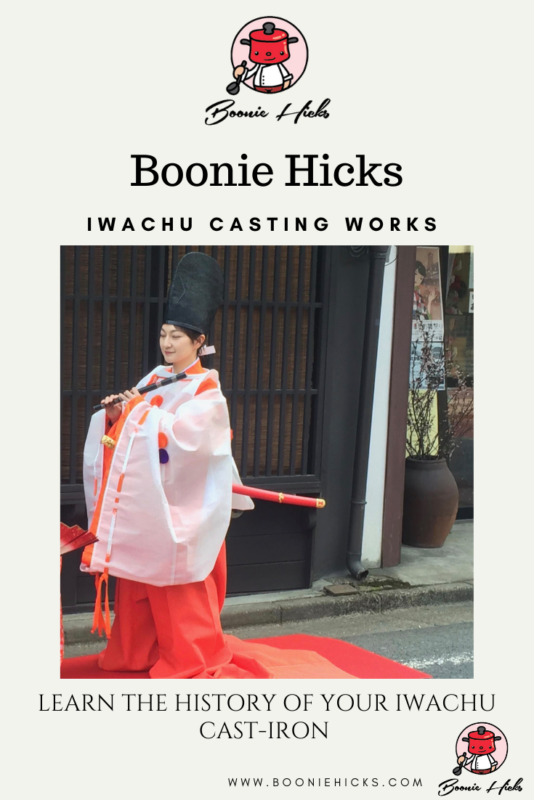
The Founder Of Iwachu Castings
At a very young age, Sueyoshi loved the charm of Nambu Ironware and became an apprentice in a local foundry. He learned all about making high-quality Nambu Ironware during his apprenticeship. After years of study, Sueyoshi became one of the most skilled Nambu craftsmen in the region.
Sueyoshi faced many challenges when it came to making Nambu ironware. War ceased production as resources were scarce. Sadly, many older pieces of ironware were taken and repurposed during this time.
Nevertheless, Sueyoshi prevailed and kept the Iwachu brand alive. Eventually, Sueyoshi’s two eldest sons took over the business. The eldest son, Yukichi, who began helping the family business when he was 12, inherited his father’s craftsmanship. Sueyoshi’s second son, Takiji, had a cheerful spirit and a keen business sense. The two of them worked together to keep the Iwachu brand going strong well into the future.
Today, Iwachu remains one of Japan’s most respected ironware brands, producing over 1,000,000 products annually.
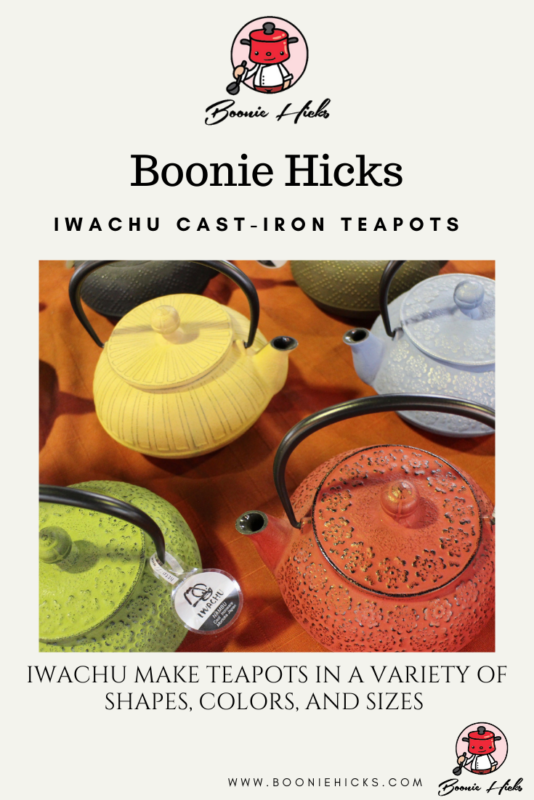
The Current Owners Of Iwachu
N & I Asia currently owns Iwachu. The parent company dates back to 1993 with just three employees. It has expanded to include some of the most trusted and well-known Japanese brands, including:
- Swiss Diamond
- Nikko
- Tanita
- Zojirushi (which is the most popular rice maker brand in Japan)
N & I Asia similarly runs Iwachu to how Zwilling J. A. Henckels operates Staub, a hands-off approach. This style allows Iwachu to maintain its quality control and expertise in casting. And become more creative with their designs and colors.
Today, you can purchase teapots of all shapes and sizes and choose various colors.
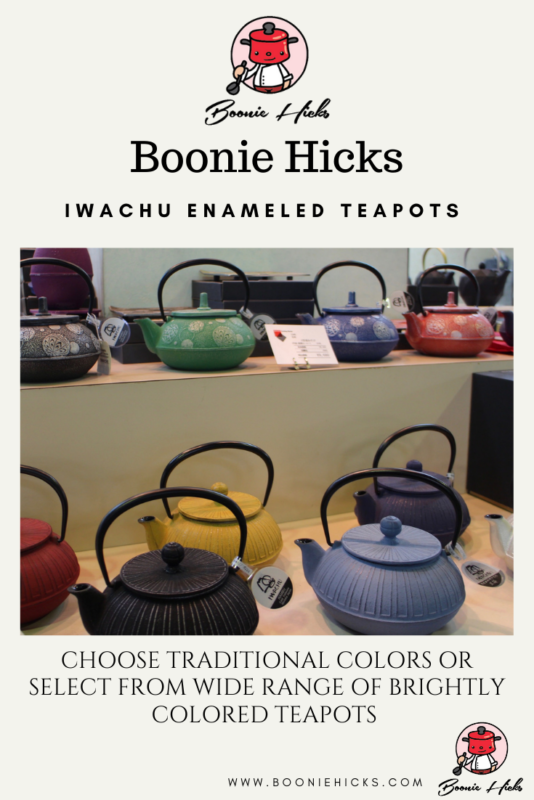
Iwachu Cast Iron Kettles
Iwachu makes beautiful Tetsubins or cast iron tea kettles. These are handmade by their in-house artisans. Tetsubins boil water for tea and do not have an enamel lining, making them more rust-resistant. However, a method of oxidization reduces the chance of rusting.
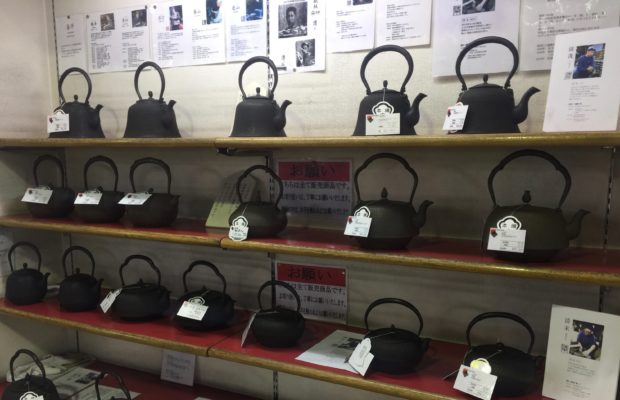
Iwachu Cast Iron Teapots
Iwachu cast iron teapots for brewing tea, so please do not use your teapot on a heat source. But because of the enamel coating, the teapots are nonporous and easy to clean. The teapots also have a handy removable infuser to make cleaning a breeze.
The Process Of Making Iwachu Tetsubins
Cast-iron tea kettles or tetsubins have been used for more than 400 years to boil water for tea. A master artisan known as a kamashi makes kettles. To become a full-fledged kamashi, these craftsmen study for a minimum of 15 to 40 years. There are about 65 steps needed to make one cast-iron tetsubin. Most of these steps require manual labor. Here is an overview of the process in the Boonie Hicks guide to cast iron kettles.
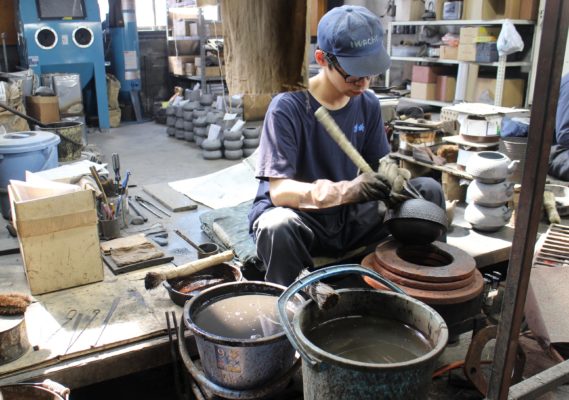
How Do Iwachu Make Their Cast Iron Kettles?
Steps | Process of making Tetsubin kettles |
Concept Design | First, the artisans design the Tetsubin. |
Preparation | Next, the drawing is copied to an iron plate about 1.5 mm thick. And cut out to make a grinding plate. |
Clay mold is formed to the desired shape | Artisans combine a mixture of sand and clay to make a mold for the Tetsubin. The mold is cut using a tool called a cow and applied to the grinding plate. |
Hand-pressing | Before the mold dries, the pattern or design for the Tetsubin is hand-pressed into the mold. |
Mold is assembled | Then, the workers assemble the outer mold with the inner mold. |
Iron is poured | Iron is melted at 1,400 ° C to 1,500 ° C in an electric furnace. Workers use a tool called a Yugumi to pour the hot iron into the space between the outer mold and the inner core. |
Mold is removed | The cast iron solidifies, and the artisans release the iron from the inner and outer molds. |
Kettles smoothed | Workers smooth and round edges. |
Rustproofing | The kettle then undergoes heat treatment in a kiln The kiln heats the iron kettle to about 250° C. Before applying, lacquer on the surface of the kettle. |
| Color is applied | A black patina called Ohaguro is applied to the outside at about 100°C to 150°C. |
Polishing | The kettle is finally polished with green tea and vinegar to give a glossy finish. |
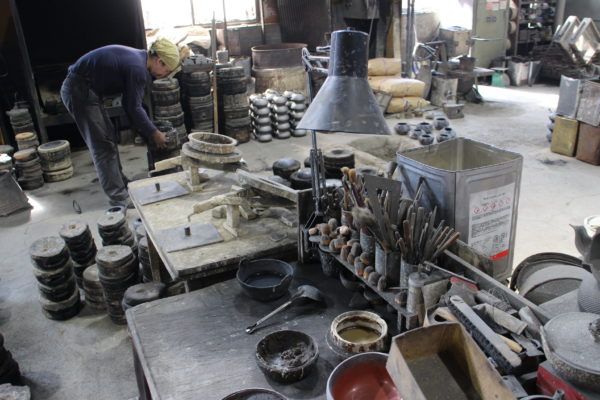
How Are Iwachu Cast Iron Teapots Made?
The process of making cast iron teapots is somewhat different for Tetsubins. They are coated with enamel on the inside to prevent rust. Here is an overview of Iwachu’s process to make its teapots. If you’re interested, I have also written an informative guide on cast iron teapots.
Sand Mold | Workers use sand molds, foundry sand, and master templates to press the design into the sand. Carefully placing a separate mold into the sand will eventually form a hollow in the teapot. |
Iron is poured | A furnace melts iron at about 1,500° C. Workers then pour iron into the mold. |
The Sand mold is removed | When the iron in the mold solidifies, the mold and gate mark are removed and checked for imperfections. The teapots are then put into a centrifuge to remove sand and smooth edges. |
Polishing | The teapot is then polished and buffed individually by skilled foundry workers until the surface is smooth and edges free of rough edges. |
Rustproofing | A feature of ironware from Japan is the oxidization process. The teapot is heated to a high temperature in a kiln, oxidizing the surface to prevent rust. |
Enameling | The staff then bake the enamel onto the inner surface at a high temperature. |
Coloring | The craftsman then paints by hand the outer surface of the teapot. |
Iwachu Cast Iron Products.
Are you looking for a new cast-iron teapot? Check out the Iwachu traditional and brightly colored teapot.
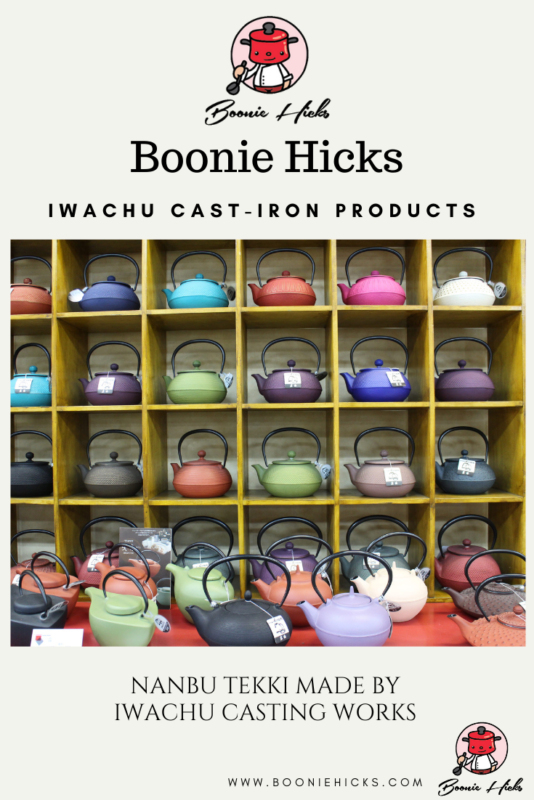
Hailstone Teapot Series
This authentic Japanese handcrafted Hailstone Teapot Series features the classic Hailstone pattern. The teapots are available in a variety of sizes and shapes. The elegance and beauty of these teapots make them perfect for tea service. The 16-ounce teapot is ideal for a romantic tea service for two. The 36-ounce teapot is suitable for a small group of friends.
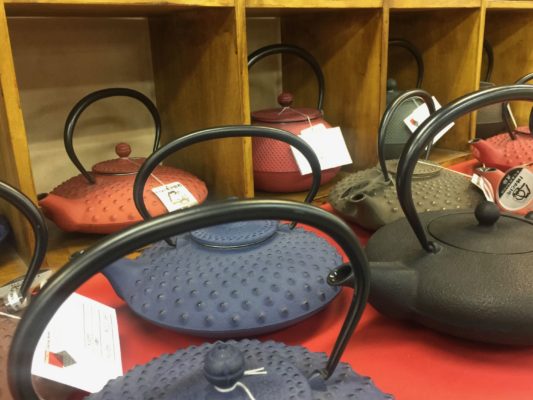
| Characteristic | This teapot is low and wide profile. It is a classical Japanese kettle shape but very different from a standard-looking teapot. And it had a bumpy exterior surface. |
Capacity | The teapot has a 16-ounce capacity. Or two standard cups. |
Interior coating | This teapot has an enamel lining on the inside. |
Removable infuser | Yes, you can remove the infuser for easy cleaning. |
Use | You can brew two cups of tea in this teapot. |
Where to buy | If you want to check out this cute teapot, here is an affiliate link to Amazon. |
All of the teapots in this series include a stainless steel infuser basket and have a rust-proof enamel coating baked on the inside. So, the teapots are perfect for steeping tea but unsuitable for open-flame use
Iwachu Japanese Artisan Iron Teardrop Teapot Series
This teardrop-shaped cast iron teapot from Iwachu is a contemporary take on a classic design. It features an elongated spout and a squat body. This design helps ensure a clean and smooth pour with no dripping.
This particular teapot has a 23-ounce capacity and serves up to four. The Teardrop Teapot is available in classic matte black, turquoise, pink, and purple. An enamel coating on the inside helps resist rust.
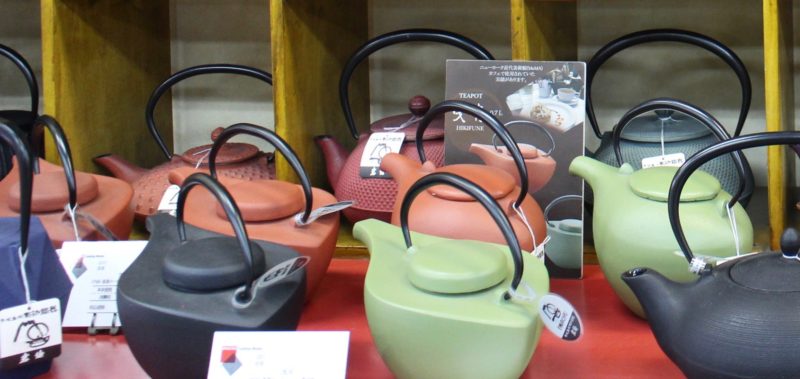
Characteristic | This teapot has a modern, sleek, yet timeless design. It has a smooth matte finish, whether you are a traditionalist like me. Or, if you prefer modern designs, you will love the look and feel of the teapot |
Capacity | The teapot has a 23-ounce capacity (2.8 full cups). |
Interior coating | The interior has an enamel lining. |
Removable infuser | Yes, the teapot has a removable stainless steel infuser. |
Use | This teapot has a 3-4 cup capacity. |
Where to buy | You can check out this pretty neat-looking teapot on Amazon (affiliate link). |
Iwachu Maple Leaf Cast Iron Teapot Series

This series features a unique maple leaf design. In Japan, maple leaves are a symbol of beauty. This 22-ounce teapot is available in gold & black, bronze, green, and red. The colors represent the beauty of autumn leaves. Like Iwachu’s other teapots, this one has a stainless steel infuser and baked porcelain enamel inside.
Characteristic | This design is so popular that other manufacturers copy the design. However, if you want an authentic Japanese teapot, look to Iwachu. |
Capacity | This teapot holds 22 ounces or 2.8 full cups. |
Interior coating | The teapot has an enamel lining |
Removable infuser | Yes, the teapot has an easy-to-clean infuser. |
Use | This teapot should hold 3-4 cups of tea, depending on the teacup size. |
Where to buy | If you want to see this nifty teapot, click the link to Amazon (affiliate link). |
Iwachu Japanese Iron Teapot, Honeycomb Series
This series of teapots features an elegant honeycomb design. The Japanese have used this hexagonal pattern as a template for samurai armor for centuries. The Honeycomb Series teapots are available in a 30-ounce capacity, perfect for tea service. They are all coated in enamel to resist rust.
The teapot comes with a removable stainless steel mesh infuser. Colors include classic black, gold & taupe, gold & cranberry, lavender & silver, gold & purple, and turquoise.
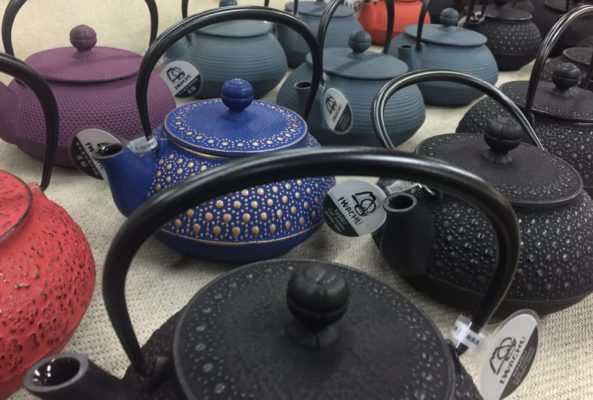
Characteristic | The surface of this Iwachu teapot is pebbly and gives the teapot a real sense of individual character. |
Capacity | The honeycomb series comes in a variety of sizes. However, it is also available in a larger 30-ounce capacity, just under 1 quart. |
Interior coating | The teapot has an enamel lining for easy cleaning. |
Removable infuser | Yes, the teapot has a big, wide, stainless steel infuser. |
Use | With nearly a quart of tea, the teapot is ideal if you have a few friends around for tea. |
Where to buy | To see this teapot, click the link, which will direct you to Amazon (Affiliate link). |
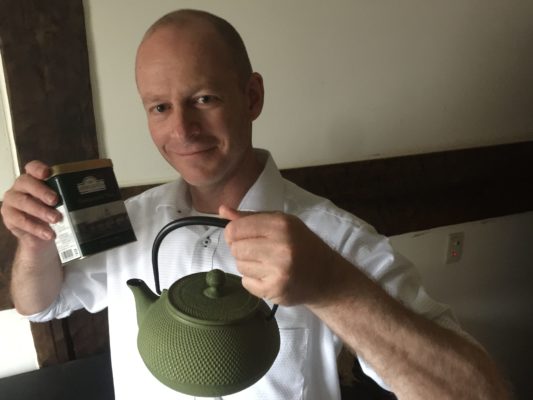
Iwachu Japanese Hobnail Arare Cast Iron Teapot Series
These teapots have a hobnail design. Tea connoisseurs prefer this classic Japanese teapot design for its simple beauty. The Hobnail series comes in 20 to 44 ounces, making them perfect for every occasion. They are available in classic black, copper, bronze, and many other color combinations.
Characteristic | This teapot has a traditional design. It is the most familiar pattern many people will recognize. |
Capacity | This teapot has a 22-ounce capacity or around 3 cups of tea. |
Interior coating | The teapot is fully enameled inside to protect it from rust and the enamel lining makes the teapot easy to rinse out. |
Removable Infuser | Yes, it has a removable stainless steel infuser. |
Use | A 22-ounce teapot is a perfect size for a couple or at work. So you can enjoy a couple of cups of tea at your desk. |
Where to buy | If you want to see a classic Iwachu teapot, Check out on Amazon (affiliate link). |
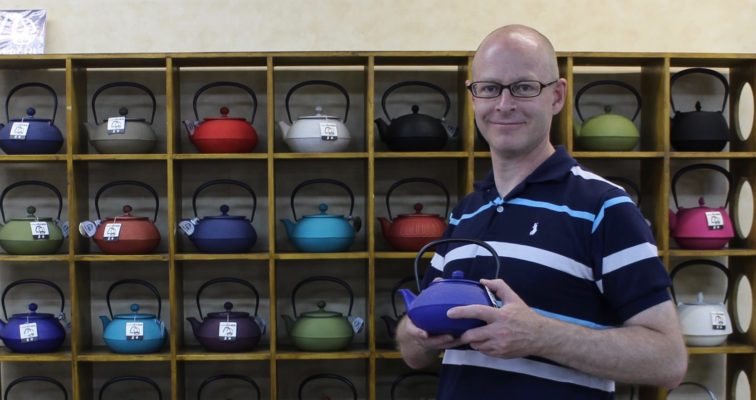
Iwachu Cast Iron Tea Kettles and Teapots – Use & Care
- Before you use your teapot or kettle, wash it with warm water. Then, dry the inside and outside of the kettle with a cloth.
- Never boil water in an Iwachu Cast Iron Teapot. These teapots have an enamel lining. So, boiling water in these teapots will damage the coating.
- Either use an Iwachu tea kettle that is safe on the stovetop. Or boil water separately in another vessel.
- You might notice white marks or red spots on the bottom of the teapot about two to three weeks after first use. These spots are typical and are no cause for concern. It keeps rust from forming. Plus, in Japan, this buildup is considered healthy as it contains iron.
- You might notice indentations on the bottom of your Tetsubin or cast iron teapot. Again, this is not unusual and is part of making the teapot. If you want to learn how to make a great-tasting cup of tea using a cast iron teapot, click the link.
Iwachu Cast Iron Teapot Care
Follow These Care Steps.
- After using the teapot, pour out the excess water.
- Then, allow the teapot to dry with the lid off.
- To keep the surface of your teapot looking shiny, soak a soft cloth in tea. Then, gently polish the outside of the teapot.
Don’ts
- Don’t leave tea standing in the teapot for long periods.
- Also, expose the teapot to salt or oils.
- Finally, don’t use harsh cleaners or detergents, which could damage the interior lining.
Final Thoughts
When you purchase an Iwachu teapot, you can be sure you will get an authentic Japanese cast iron teapot. The use of cast iron teapots dates back centuries when they were part of the traditional Japanese tea ceremonies. Iwachu has maintained a classic, timeless aesthetics in its teapot design.
Iwachu is known for having some of the finest teapot artisans in Japan. The company has been producing teapots for more than 100 years. An artisan carefully designs every Iwachu teapot. So, no two teapots are alike.
With the proper care, an Iwachu teapot will last forever. It won’t discolor, chip, or rust. No matter which Iwachu teapot you choose for your tea service, you can be sure that you will get a high-quality, timeless piece of ironware.

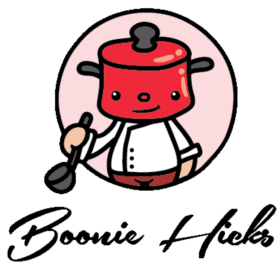
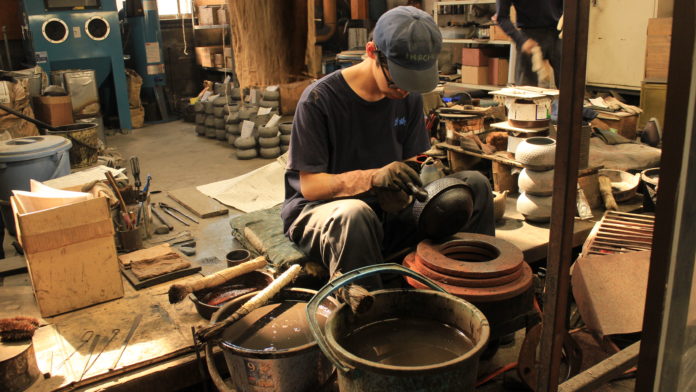
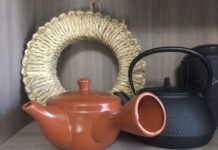
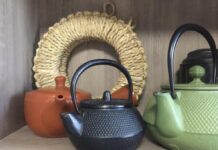
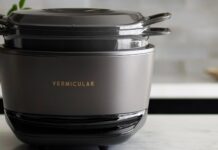



Hello, I’m a bit confused about the presence of inner surface called kamayaki in some tetsubins.
It does affect the taste of water?
Hi Fabio
Thanks for getting in touch.
I’ve only seem the term “Kamayaki” in reference to Tetsubins on one website. The writer is likely referring to the taste of water from a tetsubin with a rusted surface. I’ve heard purists say using an old rusty kettle enhances the flavor of the water. Many of these enthusiasts also use natural spring water rather than regular tap water. Because of the higher mineral content and water softness.
This level of tea expertise is beyond my knowledge. And I’m happy using a tetsubin that has undergone a second firing to prevent rust. I also use regular water from the tap. Using bottled water for a cup of tea is beyond my pay grade. But no doubt using spring water, boiled in an old rusty kettle would change the taste of the tea.
Hope this helps.
Any experience with a “Tokyo Grill”? This is a cast iron assembly of 4 main components that include a charcoal pot and 5 individual “petals” with a bowl in the center.
Hi Dennis
Thanks for sending in a question, Unfortunately, I haven’t had the pleasure of using the grill as you describe. I’ve been in Japan for quite some time, and haven’t seen anything like it. I’d love to come across one. Thanks for letting me know about know about the flower inspired grill. I’m guessing the design is Sakura shaped. I’ll be sure to keep an eye out for one.
Cheers Dennis
I have one of these teapots, and I’m wondering how old it might be? I haven’t seen the style of this one on this very helpful article.
It has lines circling the teapot and lid, with a lotus style lid handle. It doesn’t have the hobnail or hailstone or other styles I see on this article. It bears the mark of the Iwachu foundry under the spout, which is bordered by a rectangle. It has a strainer inside which appears quite old but is apparently stainless steel.
Thanks for any help, and for this article!
Hi Gabe
Thanks for getting in touch, and I’m pleased you’ve enjoyed the article.
Unfortunately, I can’t estimate the age of your teapot. But from the description of the strainer it sounds like an older model. Iwachu strainers today are made with stainless steel mesh. Older strainers on the other hand are colander like in appearance, and have holes in the bottom to steep tea.
The enameled teapot is a fairly new invention, so your pot is unlikely to be considered vintage, but just give it time and it will be.
I’m not sure of your exact model, but you might want to Google search “Iwachu Tsuki” and “Iwachu Senbiki”. These teapots have lines around the circumference of the teapot and could be similar to your earlier Iwachu teapot.
Hope this helps, and enjoy your teapot.
Hello, is there a difference between iron used for Iwachu’s tetsubins without coating and iron used for their enamelled teapots? Thanks a lot, Mau.
Hello Mau
Thanks for your question. There is little difference in the iron used between Iwachu enameled teapots and unlined Tetsubins.
However, the process of manufacturing the two vessels is completely different. You probably have already noticed the price difference, Iwachu enameled teapots are produced on a large scale useing modern manufacturing techniques. Tetsubins on the other hand are made using traditional clay molds, and the process requires a great deal of expertise and steps to produce each kettle.
Thanks Mau hope this helps.
Thank you for the writings.
I am confused at the usage of cast iron teapot between Oitomi and Iwachu brands.
In this article, it mentions that Iwachu tetsubin is used over open flames. However, the tetsubin recommend by Oitomi is supposed not to used over the flames or just weak flames. So, what is the difference between these two brands of the tetsubin?
Hi P.S.
Thanks for reaching out.
Both Iwachu and Oitomi are well respected Japanese brands. And have a wide selection of products. But generally teapots cannot be used on any heat source because of the enamel lining.
Tetsubins have a different purpose and that is to boil water. So you should be able to hang a traditional tetsubin kettle over flame. Unfortunately, the term tetsubin is commonly used in English to describe a Japanese teapot. However, the Japanese word for a cast iron teapot is Tetsu Kyusu. So many websites inaccurately describe their products.
Nearly all Japanese cast iron teapots have an enamel lining. But because of this confusion Japanese manufacturers make some teapots without an enamel layer. Instead these teapots are seasoned with vegetable oil. Similar to cast iron cookware. These teapots can be used on moderate heat to low heat. I think these work well on induction heat.
So you have three options
1. traditional kettle to boil water (usually very expensive)
2. enameled teapot to steep tea (durable and easy to clean)
3. seasoned teapot to boil and steep tea. (dual purpose but harder to clean, needs to be used on lower temperatures)
I have a few different teapots but it’s the enamel teapot I reach for first.
I have visited both foundries and they both make great products. Go for one you think looks the best.
Have fun